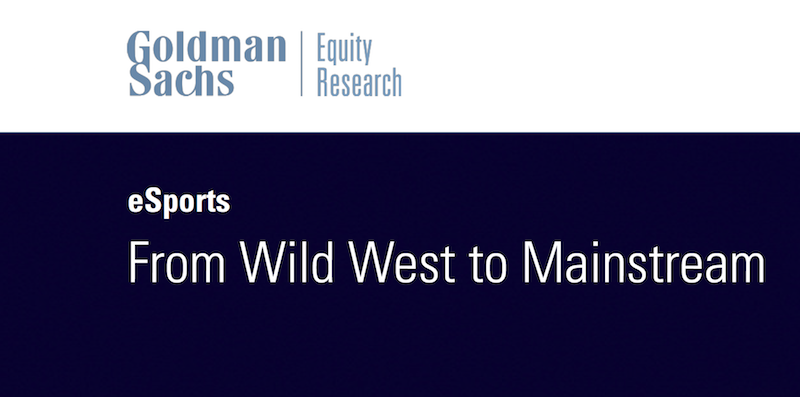Goldman Sachs believes esports are moving into the mainstream. Growing prize pools for tournaments, the rise of live-streaming and improving infrastructure for pro leagues, have all paved the way for esports to reach nearly 300 million viewers by 2022. For game publishers, Goldman believe esports will not only help to increase audience reach and engagement, but also drive direct revenue through established leagues. They see further tailwinds for the broader esports ecosystem (e.g. online video platforms, hardware manufacturers and chip makers) and outline this thinking in the Goldman Sachs Esports Investment Report 2018.
Goldman believe esports are at the cross-section of some powerful trends: social connections being formed and maintained online, digital consumption of video, and global growth in the gaming audience. Looking ahead, they see numerous public and private investment opportunities that they believe will benefit from the structural growth of esports, both in terms of audience and, increasingly, monetisation, as the requisite infrastructure is built to transition esports from the “Wild West” of sports to a full-fledged professional sport.
The audience opportunity. In 2018, Goldman Sachs estimated the global monthly audience for esports will reach 167m people, based on data from Newzoo, and a total online population of over 3.65bn people globally (to go along with 2.2bn gamers). However esports viewers represent just 5% of the online population TAM, which suggests that there should be plenty more runway for audience growth. By 2022, we estimate the esports audience will reach 276m.
Due to the growing popularity of survival-based games Fortnite and PUBG, Goldman Sachs believe esports viewership is moving more into the mainstream, which should support a 14% audience growth CAGR for the next 5 years. Recently, Epic Games announced that it would set aside $100m in prize pool for the first year of Fortnite esports tournaments, nearly the size of the entire esports prize pool in 2017. With growing incentives for esports players, and by extension more interest from the casual observer, Goldman believe the esports audience should continue to outpace the growth of traditional leagues.
League infrastructure is creating meaningful opportunities for direct monetisation. In the early years of esports, there was little organization or infrastructure, and as a result, the massive audience of esports did not translate into meaningful revenue streams for players, team owners, etc. But in 2017, Riot Games created introduced a franchise model for the North American and EU League of Legends leagues, while in January of 2018, Activision Blizzard launched the Overwatch League. Goldman Sachs believe these leagues created the requisite infrastructure that will allow esports to finally start to close the monetisation gap relative to other established sports leagues.
In 2017, Goldman estimate esports generated $655mn in annual revenue, including 38% from sponsorships, 14% from media rights, and 9% from ticket revenue. But by 2022, Goldman expect media rights to reach 40% of total esports revenue as massive audiences and associated revenue for established online video platforms like Twitch, YouTube, Douyu, and Huya will be able to support a growing pool of media rights fees paid to top publishers for their content. As media rights and sponsorship continue to grow, along with the formalisation of pro sports leagues, Goldman Sachs expect total esports monetisation will reach $3bn by 2022.
Fortnite and the “Moneymaker” effect. In 2003, Chris Moneymaker, an accountant and amateur poker player from Tennessee, outlasted a field of 839 players to win the World Series of Poker. His victory sparked a meteoric rise in the popularity of online and tournament poker. Just 3 years after his victory, the first place prize money for the WSOP increased to $12mn in 2006, up from $2.5mn in 2003. The relevant lesson here is that Moneymaker elevated poker’s profile as a sport to the mainstream — and Goldman believe Fortnite is doing the same thing for esports.
The Fortnite phenomenon has been well-documented, but by way of background, the title has reached more than 125mn players on across console, PC, and mobile. According to SuperData, as of April the game generated $296m of revenue across platforms, an annual run rate of $3.6bn — more annual revenue than any major console or PC game today. As Fortnite brings more new gamers to the ecosystem, particularly those in younger demographics, Goldman believe the esports audience – and associated revenue streams – will benefit over time.
A new paradigm for distribution. Unlike traditional sports, the vast majority of live esports viewership is online, the same medium where multiplayer game play takes place and through which the esports audience consumes media content. In the coming years, Goldman Sachs believe esports content (particularly live) will continue to grow in value, not only due to its audience reach but also the engagement it commands, creating an opportunity for advertisers to target a captive and young demographic.
In the West, Goldman believe Twitch and YouTube Gaming are the primary distribution channels for live and recorded esports content. Because Twitch captures 84% of live-streaming viewership in North America, Goldman currently estimate that it over-indexes on revenue relative to YouTube, with 54% of gaming content gross revenue market share in 2017 relative to 22% for YouTube. Goldman identify three major monetisation channels: advertising, tipping and sponsorship. By 2022, they model esports industry advertising revenue of $429mn (25% 5-year CAGR), tipping revenue of $372mn (24% 5-year CAGR), and sponsorship revenue of $1.1bn (34% 5-year CAGR).
Asia is leading the way for eSports globally. China’s esports market is built upon the largest gamer base in the world, with approximately 442 million gamers as of 2017, a 57% penetration rate of Chinese internet users, according to CNNIC. By 2018, China will contribute one third of the global game industry’s total revenue, according to Newzoo. For Asia more broadly, there are 89 million esports viewers, according to Newzoo, roughly half of global audience in 2018E. Goldman believe the popularity of esports in this region could be a leading indicator of what is to come in Western markets, as markets like China and Korea already outpace the North America in some measures of technological change like smartphone penetration.
Venture investment in esports has stepped up meaningfully this year. Since 2013, there has been $3.3bn of venture capital investment in esports-related start-ups. In 2018 YTD, we have already seen $1.4bn of investment, a nearly 90% y/y increase from from the total amount of funding in 2017. The uptick was largely driven by two outsized investments made by Tencent in Chinese online video platforms Douyu and Huya of $630mn and $461mn, respectively. Goldman believe these investments in particular underscore two key trends: 1) the opportunity for live-streaming to monetise the growth in esports in a way that few other esports-related businesses can, and 2) the popularity of esports in Asia in particular.
To download the full Goldman Sachs Esports Investment Report 2018, click here.
If you would benefit from the advice of an esports agency, Strive Sponsorship can help. Contact us for esports sponsorship, commercial, content, operations, investment and communications consultancy services.













